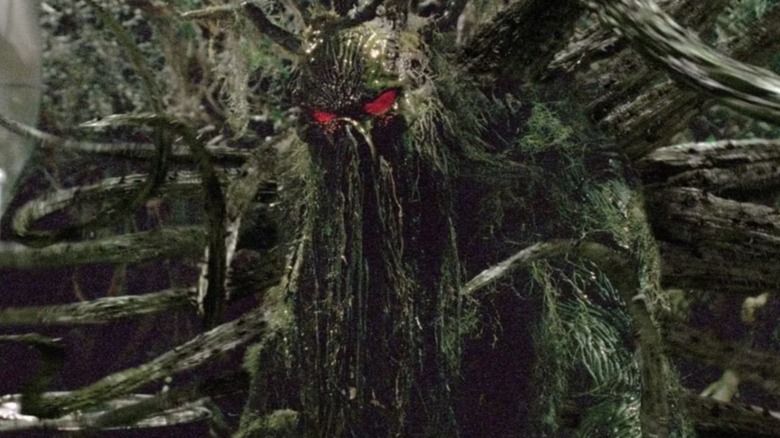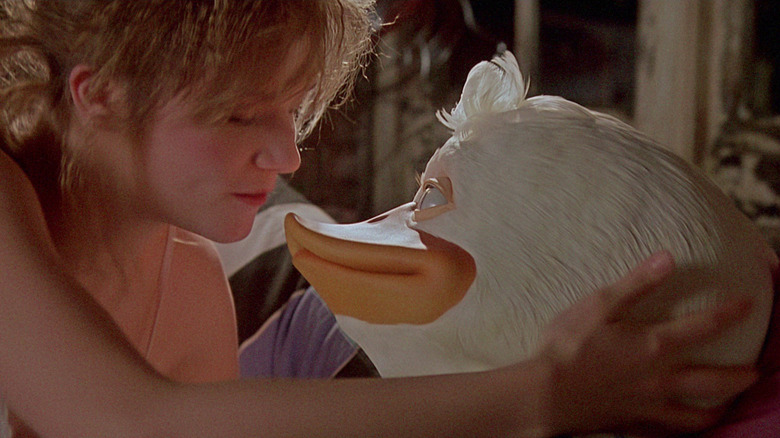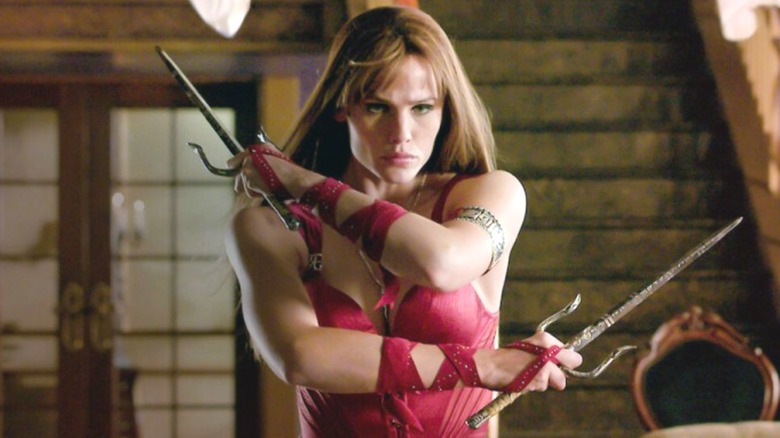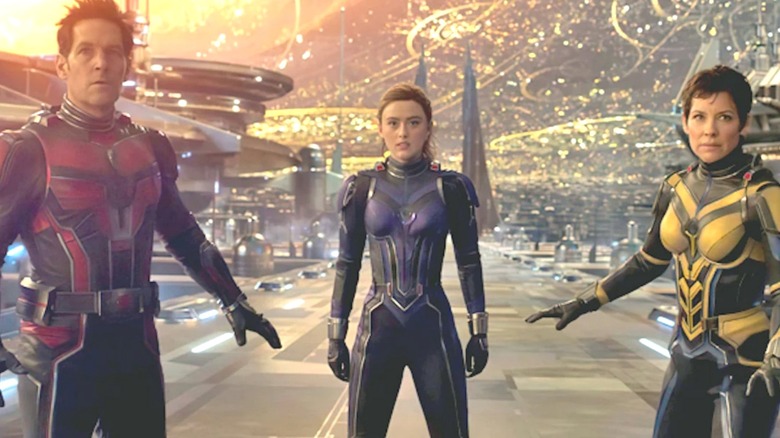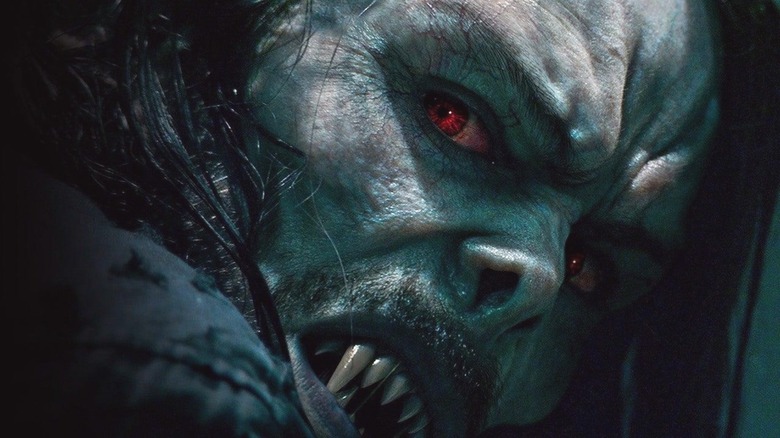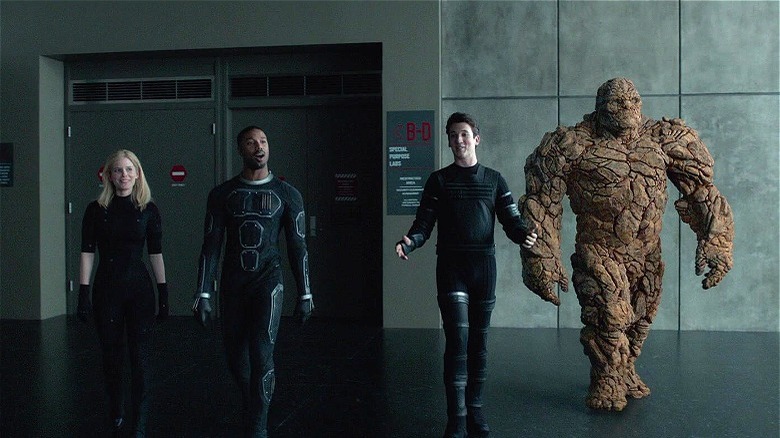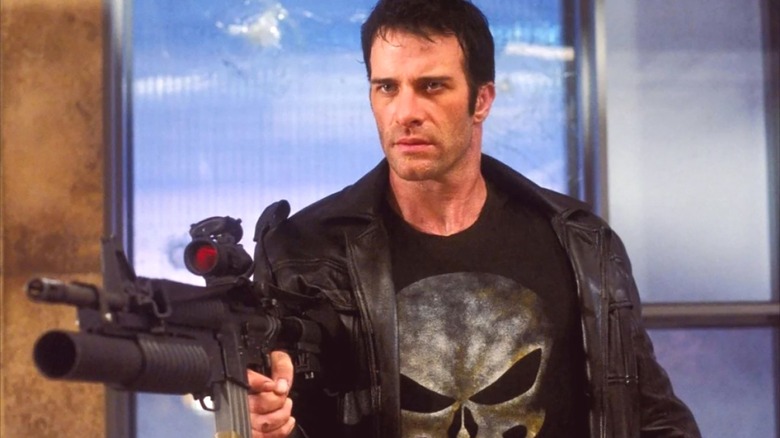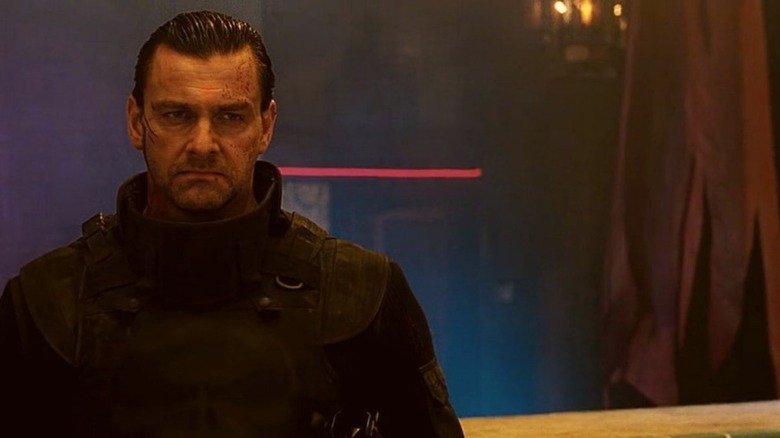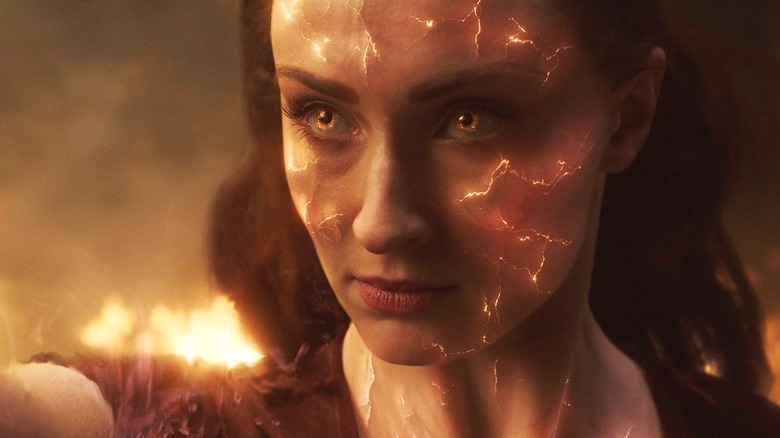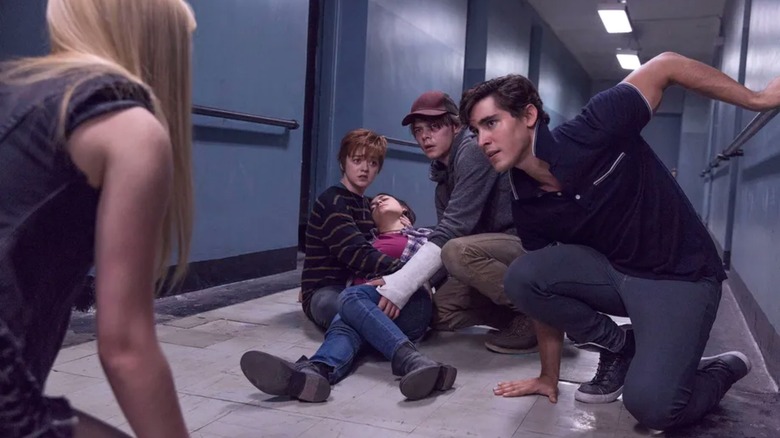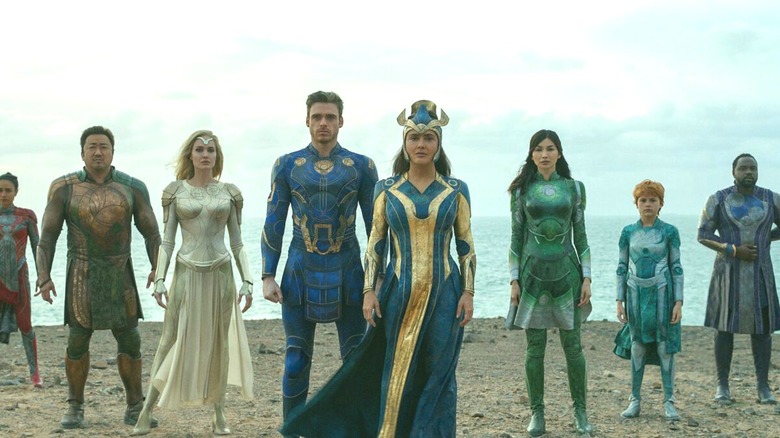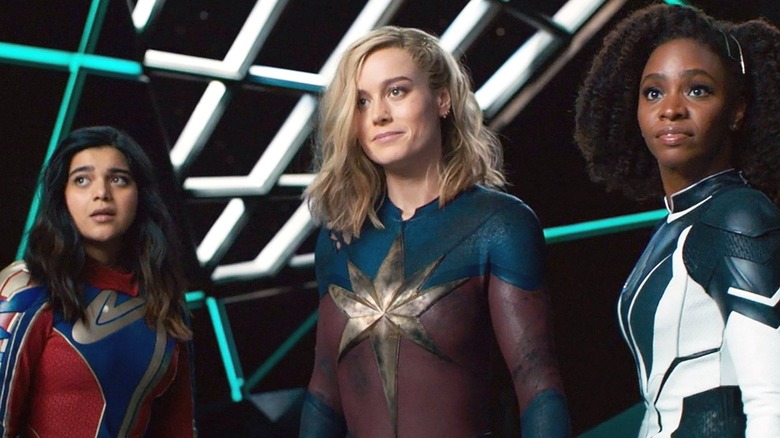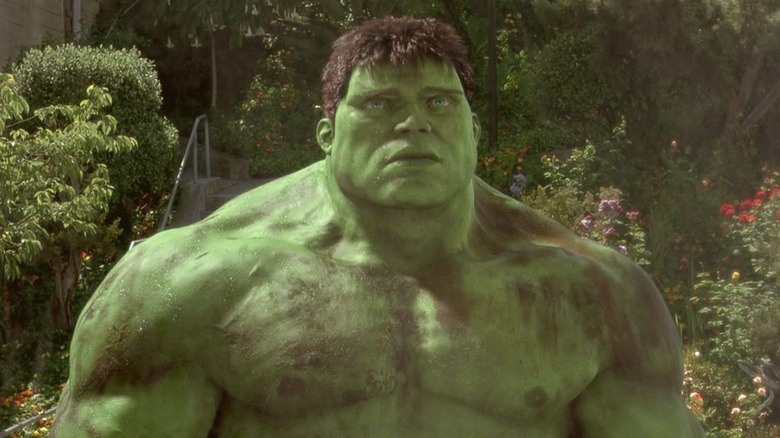Why These Marvel Movies Bombed At The Box Office
The Marvel Cinematic Universe is the largest and most profitable film franchise of all time, and it’s likely to retain that status for a long time. Many MCU films have been successful, but not all of them. Some missteps in television series and feature films have upended Phase Four of the MCU’s timeline, making for a variety of recent misfires in adapting Marvel Comics’ many characters.
Of course, the MCU’s first film, “Iron Man,” wasn’t the first movie to feature Marvel characters. For decades, Marvel superheroes appeared on the small and silver screens, but not every movie did well. In fact, most adaptations prior to the advent of the MCU were clumsy messes, and a lot of movies bearing the Marvel brand bombed at the box office.
Before superhero films were the norm, characters like Howard the Duck and Man-Thing made it to the big screen, but not to worldwide acclaim and financial success. There are many reasons a movie might bomb at the box office, which happens when a film doesn’t hit its break-even point (usually at least twice the production budget), and while each of these Marvel movies may have attempted something special, all of them bombed at the box office.
Almost nobody knew there was a Man-Thing movie
Marvel Comics horror fans were elated to see Man-Thing come to life in live-action via the MCU’s 2022 “Werewolf by Night” TV special. It was an excellent version of the character, but what many Marvel fans don’t know is that it wasn’t the first time he graced the screen. Back in 2005, he starred in an incredibly low-budget “Man-Thing” movie.
If you’re wondering why this is the first time you’re hearing about this, you’re not alone. The movie was budgeted at $5 million and only raked in $1.1 million in a limited overseas release. The film also premiered on the Sci-Fi Channel, but hardly anyone noticed due to minimal marketing. Had you heard of the film and sat down to watch it, you probably weren’t impressed, as it’s objectively terrible.
“Man-Thing” was produced independently, not by Marvel, and the film’s tiny budget shows. The production looks shoddy, and the VFX are about as rudimentary as was possible in 2005. Few who watched the film enjoyed it, and it maintains a 14% score on Rotten Tomatoes, where critics decried the visuals and boring, generic story.
Howard the Duck can’t erase the creep factor
Even if you’ve never seen it, odds are you’re aware of how utterly awful “Howard the Duck” truly is. The film was an ambitious attempt at adapting an obscure Marvel Comics character into live-action, and it did have a lot going for it. With everything from the work of Industrial Light and Magic to an excellent cast, the film should have worked.
The main problem with “Howard the Duck” that’s difficult to overcome is that it tries too hard to be a comedy. On top of that, it includes several aspects of the characters that aren’t pleasant to watch — specifically, the taboo romance and obvious attraction between Howard (Chip Zien) and Beverly (Lea Thompson).
Interspecies romances may work on “Doctor Who,” where most folks appear human, but in “Howard the Duck,” it’s just creepy. Add to that the overt silliness of the plot, which was overshadowed by the impressive special effects. Unfortunately, the result was a $37 million film that only raked in $37.9 million at the global box office. “Howard the Duck” flopped, but Howard eventually made his way into the MCU via CGI and Seth Green’s vocal talent.
Even the film’s star didn’t like Elektra
“Daredevil” wasn’t the greatest adaptation of the character, but the film made money, so the studio went forward with “Elektra” two years later. Jennifer Garner’s portrayal of the character in “Daredevil” suggested she’d be able to carry her own film, but it didn’t happen. While Garner’s work in “Elektra” is good, she was hampered by a terrible script.
The best actors in the world cannot overcome crummy dialogue, terrible plotlines, and cheesy characters, which is what you have in “Elektra.” The film was panned by critics and audiences alike, so the $57 million box office take was barely enough to scratch the surface of its $43 million budget. Hardly anyone liked the movie, including the film’s star.
Garner’s ex, Michael Vartan, told Us Weekly (via Far Out magazine), “I heard [‘Elektra’] was awful. [Jennifer] called me and told me it was awful … She had to do it because of ‘Daredevil.’ It was in her contract.” It’s never a good sign when the lead in a film thinks it’s awful, but to her credit, Garner’s opinion on the film mirrors that of nearly everyone who bothered to sit down and watch it.
Ant-Man and the Wasp: Quantumania jammed too much into the film
The MCU’s Phase Four failed to build on the hype generated by “Avengers: Endgame,” but to be fair, that’s a tough hill to climb. Regardless, Marvel Studios tried several series on Disney+ and a number of movies, which didn’t work as well as the studio would have liked. “Ant-Man and the Wasp: Quantumania” is one such film, and while it made a decent amount of cash, it wasn’t enough — especially for an MCU entry.
Marvel spent a ton of money bringing “Quantumania” to theaters. The film’s production budget, which was initially set at $200 million, exploded to a staggering $326 million — nearly as much as “Endgame.” While the film made $476 million, that wasn’t enough for the studio to break even.
Part of the reason “Quantumania” failed was because it attempted to emulate the humorous aspects of director Taika Waititi’s take on the “Thor” franchise. As it happens, his second “Thor” film, “Love and Thunder,” also failed to achieve the desired results. On top of that, “Quantumania” crammed way too much into its confusing plot, its major villain was played by an actor with some very real legal problems, and it was heavily criticized for its VFX despite their cost.
Morbius was a sloppy mess
Sony’s ownership of the film rights to Spider-Man and his associated characters has made adapting the comics somewhat hit or miss. Marvel Studios forged an agreement to bring Spidey to the MCU, but many of his allies and enemies remain in Sony’s Spider-Verse. One such character, Michael Morbius, found his way to live-action in 2022. “Morbius” features Jared Leto in the title role, but the results weren’t great.
The film’s script wasn’t up to par with comparable MCU films, it included poorly-choreographed fights, problematic pacing, and a heavy reliance on CGI particle effects, which make those fight sequences nearly impossible to follow. Additionally, Sony’s penchant for altering its Spider-Man characters beyond how they appear in the comics upset fans.
This alienated a preexisting fanbase expecting to see their favorite characters translated to the silver screen with at least some accuracy. That cannot be said of Michael Morbius’ characterization in the film, which had a tough go at the box office. “Morbius” came close to breaking even, making $167 million on a $75 million budget. A subsequent re-release flopped again, with $300,000 in ticket sales before Sony pulled the plug … again.
Nobody asked for a gritty Fantastic Four reboot
As of 2024, Marvel Studios has yet to produce a “Fantastic Four” film despite four having been made previously. The first was never released and the next two didn’t entirely disappoint. The second, “Rise of the Silver Surfer,” didn’t make enough money to garner a third film, so the franchise sat until 2015, when Fox dusted it off for yet another reboot.
The “Fantastic Four” comics have always been somewhat lighthearted and humorous, but the gritty remake in 2015 dumped all of that and went in an entirely different direction. As a result, the long-beloved characters didn’t match up to what fans expected from a “Fantastic Four” adaptation, and the result was a movie that was universally panned.
The film cost $120 million, and it made $167.8 at the box office, making “Fantastic Four” a certified box office bomb. One major problem surrounded the film’s director, Josh Trank, who spoke out negatively about his own movie hours before it premiered. Trank blamed studio interference for the film’s problems. This conflict didn’t entice many to turn over their hard-earned cash to see yet another failed attempt at adapting “The World’s Greatest Comic Magazine!”
The Punisher got too cheesy for its own good
The first Punisher feature film released to theaters arrived in 2004, starring Thomas Jane as the titular vigilante superhero. The film fixed many of the problems with Dolph Lundgren’s 1989 straight-to-video take on the character, including giving him his iconic skull logo. It also referenced a lot of deep cut “Punisher” lore by exploring many of his associated characters and villains.
Unfortunately, while “The Punisher” had a lot going for it, including a stellar cast, it did not do well at the box office. The budget was relatively small at $33 million, but it only made $54 million in ticket sales. This, coupled with DVD sales, was enough to garner a sequel-turned-reboot, but as far as its theatrical performance, “The Punisher” was lackluster at best.
Part of the problem is how grim the film comes off: there’s not even much satisfaction in seeing the bad guy, Howard Saint (John Travolta), pay for killing Frank Castle’s family. Travolta is also a bit over-the-top and more comical than threatening, which doesn’t balance well when contrasted against Jane’s evocative depiction of the character. Critics weren’t impressed either, making “The Punisher” a box office bomb.
Punisher: War Zone’s violence was cartoonish and inappropriate
Marvel had a rocky road bringing the Punisher to life on the big screen. Dolph Lundgren gave it his best in 1989, and he was followed by Thomas Jane. Had things worked out, Jane would have reprised his role in a sequel, but some time in development hell and other issues made that impossible. Instead, the studio behind the property, Lionsgate, went with a reboot starring Ray Stevenson.
“Punisher: War Zone” was a reimagining that nobody asked for, seeing as the prior “Punisher” wasn’t especially well received. Regardless, they made the movie, doing it with a comparable budget. Instead of throwing the needed funding into the project, the budget was capped at $35 million. That limited special effects and makeup, which became problematic.
“War Zone” features all the graphic violence you’d expect in an R-rated Punisher film, but it doesn’t come off as gory or gritty. Instead, the violence is over-the-top, but in a bad way. It’s campy and limited, making “War Zone” unbelievable, and while Stevenson’s portrayal of Marvel’s gun-toting vigilante was exceptional, he couldn’t save the film, which only brought in $10 million at the box office.
Dark Phoenix botched one of the X-Men’s greatest stories
There are many amazing “X-Men” stories from more than 60 years of books, and “The Dark Phoenix Saga” from “Uncanny X-Men” #129–138 is one of the best. The story has been adapted into animation effectively, but when it came time for a live-action treatment via 20th Century Fox, things went a little off the rails.
“Dark Phoenix” was the fourth prequel and 10th “X-Men” film produced by Fox, but it’s also the most despised. The movie wasn’t cheap, costing the studio $200 million, but it only brought in $252.4 million in global ticket sales. The biggest problem fans had with the movie was how different it was from the comics. Important character elements were disregarded, making for an unsatisfying adaptation.
There are several reasons why “Dark Phoenix” bombed at the box office, including the fact that the franchise already did a version of this story in “X-Men: The Last Stand,” which was also a disappointing adaptation. On top of that, the film had stiff competition upon release; it didn’t utilize its best actors, preferring to focus on other characters, and critics and fans didn’t hold back in trashing it, killing what little positive word-of-mouth it may have generated.
The New Mutants was dumped on Disney+
20th Century Fox spent a lot of time and money developing “The New Mutants,” which spent years in development hell. Production had a few starts and stops throughout the process, and thanks to the COVID-19 pandemic and other issues, it had a rocky release. The film was initially slated to premiere in 2018, but delays pushed it to 2020.
By the time it finally made its way to theaters, Disney had finalized its acquisition of Fox. This changed the business plan for the “X-Men” franchise, which included “The New Mutants.” This was the final film in Fox’s pre-Disney “X-Men” franchise, but instead of promoting it and trying to get people to watch, the film was given a limited August 2020 release — with COVID still keeping many theaters shut down — before being dumped on Disney+.
This move, as well as a lack of widespread promotion, effectively doomed “The New Mutants” from the start. The film cost Fox $67 million to produce, but it only pulled in $49 million in ticket sales. Disney doesn’t release streaming figures for its movies, so how it did on Disney+ is anyone’s guess. Either way, many critics also felt that the film wasn’t deserving of 94 minutes of your time.
Eternals was too obscure even for Marvel fans
The MCU dug deep to bring “Guardians of the Galaxy” to life, and both the original film and its two sequels were massive hits. This led to movies like “Eternals,” which included a much larger cast and greater expense. Still, while the characters have been around for decades, they’re not the most well-known group of Marvel Comics heroes.
“Eternals” hit theaters in late 2021, which wasn’t a spectacular time to release a film. The movie features a large cast of characters and plenty of CGI, and it was incredibly expensive. Before tax subsidies that cut $36.4 million, the studio dropped $272.6 million on production – $40 million more than planned. The expenses weren’t overcome by the film’s $402 million box office take, resulting in a $52.6 million loss.
COVID still kept a lot of people away from theaters, and audiences didn’t connect with the characters like they did with the Guardians or Avengers. The film was largely forgettable, outside the giant hand reaching out of the Earth’s crust that everyone in the MCU seemingly forgot about, making “Eternals” a failed experiment. Even with the pandemic behind it, “Eternals” remains a black sheep of the MCU’s Phase Four.
Not even Dakota Johnson watched Madame Web
Few recent films have been as universally despised as “Madame Web,” and there are numerous reasons why the movie bombed. The film adapts characters from “Spider-Man” comics, but isn’t connected outright to Peter Parker or anything else Spidey-related. This isn’t a great way to connect with fans either, but more than that, the characters in the film are nothing like the comic book creations that inspired them.
This alienates an existing fanbase, but there’s more to it than that. Most people don’t know who Madame Web is in the comics unless they’re avid readers, so this was a film nobody really asked for. It was eviscerated by critics, garnering an 11% rating on Rotten Tomatoes. Rolling Stone called it “the ‘Cats’ of superhero movies” — hardly a comparison that filmmakers desire.
The script is terrible and filled with awful dialogue nobody would say unless they were paid to … like the actors in the film. On top of everyone else disliking “Madame Web,” its star, Dakota Johnson, described the plot as “AI-generated” (via Forbes). She claimed that she never watched the movie, and the film’s promotional tour was … unenthusiastic. “Madame Web” cost Sony somewhere in the low $100 million range, and it only brought in $100 million.
The Marvels required too much homework
“Captain Marvel” was a fun departure from standard MCU films, taking place in the past and looping Samuel L. Jackson’s Nick Fury into the story. The film’s plot — not to mention its billion-dollar box office gross — demanded a sequel, but it didn’t arrive for years. In the meantime, Disney released “WandaVision” and “Ms. Marvel” on Disney+, and while “WandaVision” at least did well, both series also became a prerequisite for “The Marvels.”
You could watch “The Marvels” without knowing who the adult Monica Rambeau (Teyonah Parris) or Kamala Khan (Iman Vellani) are, but you’d be pretty lost. The film’s exposition almost demands that you already know those shows before watching the movie, which alienated some viewers. The film was also set after another failed Marvel series, “Secret Invasion,” which didn’t perform well for Disney+, causing more problems.
“The Marvels” is a fun yet unimportant superhero movie starring three protagonists only a handful of viewers know well enough to follow. Brie Larson’s Captain Marvel was fully established, but the other two weren’t. A near-total lack of promotion due to the SAG-AFTRA strike, scenes set on a planet where everyone sings, a B-grade villain, and superhero fatigue didn’t help this $219.8 million box office bomb that only made $206 million at the box office.
Ang Lee’s Hulk didn’t connect with audiences
Years before the MCU dominated popular culture, director Ang Lee made “Hulk,” the first big-screen adventure for Marvel’s popular green-skinned rage monster, who had already starred in his own live-action TV series and a handful of TV movie sequels. This was a big deal at the time, and a lot of effort went into honoring the comics through brilliant cinematography that utilized panels and other comic book tropes to visually drive the film’s narrative.
While the VFX don’t compare to what exists decades later, it wasn’t bad for 2003, and fans finally got to see the Hulk in live-action on the big screen. Unfortunately, the film features several significant departures from the source material, which fans never appreciate. On top of that, the film is very cerebral, which put off some viewers, and its glacial pacing didn’t help either.
“Hulk” was an ambitious project, and it shows, but it’s since been overshadowed by more comic-accurate fare in the MCU. Lee took the character a bit too seriously to depict him properly, making the film a largely forgettable mess. “Hulk” cost Universal $137 million to produce, which was substantial in 2003. The film made $245.2 million, also quite a lot of money — but not enough for the studio to break even.



